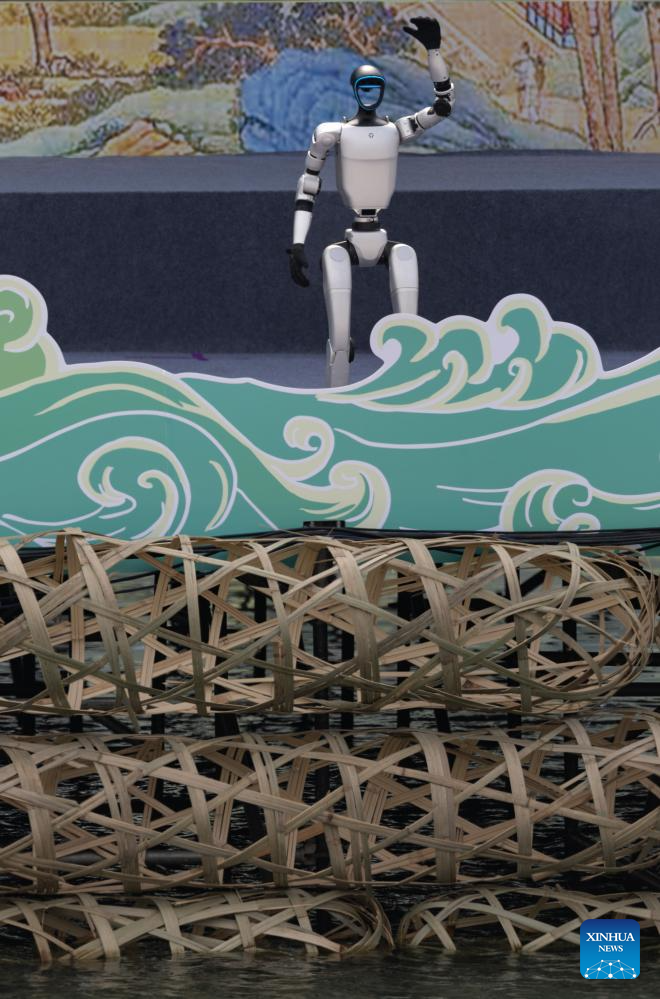Monica Cheru, Managing Editor
Sichuan, China-— At the Dujiangyan Water Opening Ceremony, clad in hanfu, a lovely traditional Chinese silk robe that would have been worn by a courtier in the days of some long-buried emperor, I watched the reenactment of a ritual performed for more than 2000 years.
One of over 1000 guests, including some who had travelled from places like Russia and Italy, I felt moved and honored to witness the elaborate ceremony, mired in tradition but with interesting modern twists.
The first was the humanoid robot host, with an engaging, witty repartee for his human counterparts.

Then there was the placement of two youths from this age into a conversation with a revered poetess from the era long gone.
The Minjiang River surged free, once again a plus 2,000-year-old system that refuses to fossilize.
Li Bing’s masterpiece isn’t a static monument but a living blueprint. His 256 BC design—dividing the Minjiang River with the Fish Mouth Levee, flushing silt via the Flying Sand Weir, and channeling water through the Bottle-Neck Channel—was revolutionary.
He had to face off against naysayers and then inspire laborers to see through the backbreaking work of literally splitting a mountain in half with their bare hands.
But the true genius lies in perpetual reinvention. Each successive generation has not only venerated Li Bing’s feat, but they have also constantly added to it.
The current custodians, who belong to the digital age, are putting their mark accordingly. When the 2008 earthquake cracked its stones, engineers embedded sensors to monitor stress fractures.
Today, AI predicts floods, drones clear debris, and hydropower from the same river charges TGood’s EV networks.
I could not help comparing this to Rome’s Baths of Baths, where aqueducts once channeled thermal springs into lavish pools.
By 400 AD, the system collapsed—not from barbarian invasions but from ossified thinking.
The Romans perfected gravity-fed water delivery but left no room for adaptation. Their relics now host tourists, not innovation.
Or consider Egypt’s shadufs, a 4,000-year-old irrigation tool still used to lift Nile water. Its simplicity is poetic, a testament to ingenuity without evolution. Where are the AI-operated shadufs that can administer water to each plant in exact quantities on demand? After mixing it with the right nutrients and disease control ingredients.
Related Stories
But most of all, I thought of my own beloved country. Of the Great Zimbabwe monument, which gives my home province its name of Masvingo.
A study revealed in 2023 showed that there were “dhaka pits”—massive, circular reservoirs that stored rainwater and groundwater, sustaining a city of 18,000 in a drought-prone region.
Research team discovers extensive water management...
These weren’t mere clay quarries but a “climate-smart” system, blending hydrology and topography.
Why did Dujiangyan thrive while Zimbabwe’s dhaka pits faded? I think the answer isn’t technology but mindset.
Dujiangyan custodians treat Li Bing’s legacy as a challenge, not a shrine. Each improvement—from Qing dynasty bamboo weirs to AI-powered canals—honors his great idea and builds on it.

water-The Dujiangyan Irrigation System covers close to 800,000 hectares, delivering one-quarter of Sichuan’s adequate irrigated farmland and grain output, supporting one-third of its 84 million population, and contributing nearly half of the province’s US$ 825 million GDP.
Meanwhile, we have dismissed Great Zimbabwe’s builders as “primitive”, severing the thread between past and present.
What if we reimagined our heritage as a springboard for an innovative future?
Adapting to climate change with AI models trained on ancestral knowledge systems such as knowing when to plant.
Imagine Harare’s engineers merging Great Zimbabwe’s drystone masonry with graphene-infused concrete for climate-resilient infrastructure?
Or they modernized Dhaka weirs along Mukuvisi to depollute the stream before it discharges into Lake Chivero.
Dujiangyan’s lesson is clear: water systems survive when they evolve. The Minjiang River’s custodians never stop asking, “What would Li Bing build today?”
Zimbabwe’s challenge is to pose the same to the Dhaka pits’ architects. What would they envision and bring to life with modern-day technology?
Years after completion of the Tugwi Mukosi Dam, would they allow the nation to be a perennial beggar for handouts, or would they have created an irrigation and energy electricity production system that would ensure food security and prosperity for a country with a population of less than 20 million?




















Leave Comments